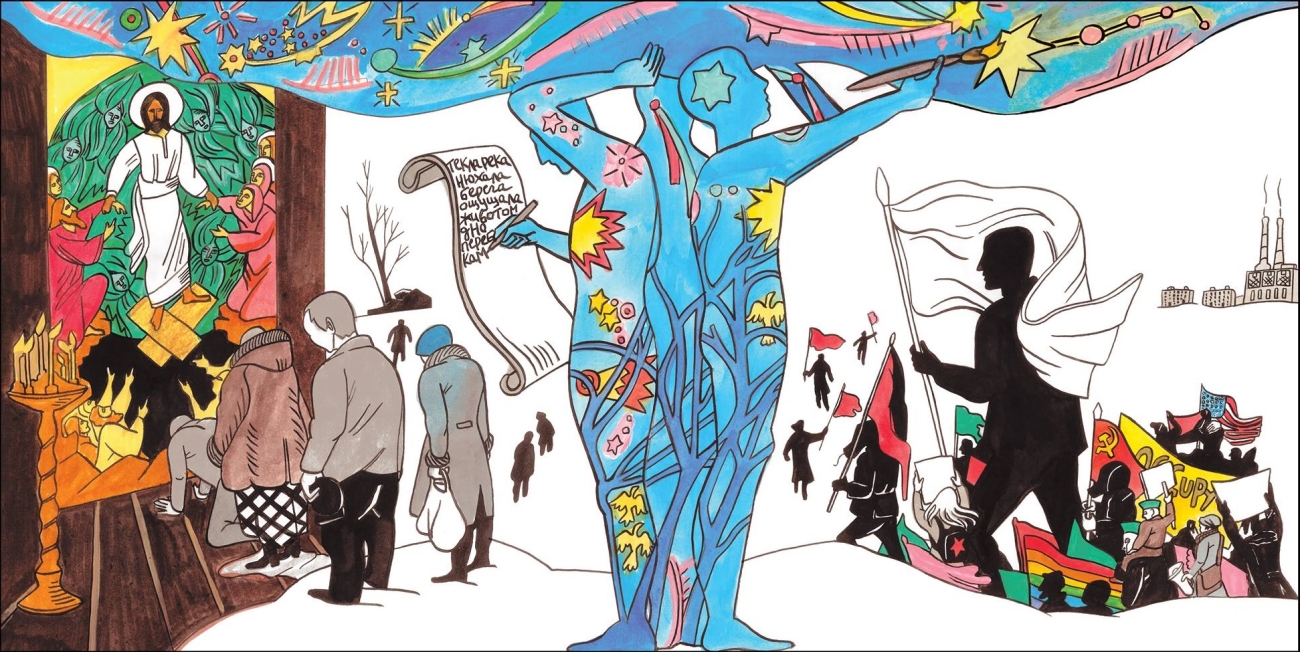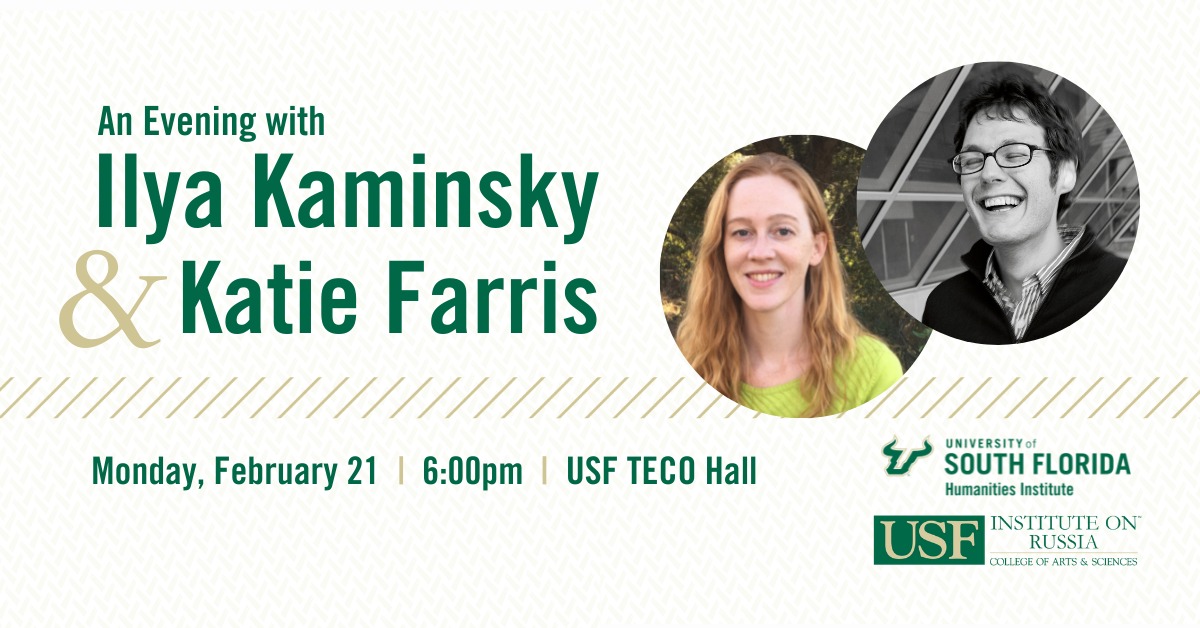In Spring 2020, the COVID-19 pandemic forced universities and colleges to cancel public programming or to hold virtual events. It also gave fresh impetus to ongoing discussions at the Melikian Center, on how to better inform the US public about culture, identity, and politics in Russia, Eurasia, and East Europe. As was the case in the various citizen-diplomacy initiatives of the late 1980s, including the “space bridges”, constraints on physical travel can open new pathways of meaningful interaction and learning across borders.
Creative Horizons was a collaboration between ASU’s Melikian Center, the Havighurst Center at Miami University, Ohio, and the Institute on Russia at the University of South Florida. Alongside support for faculty and students at their respective universities, all three units share a commitment to promoting a greater understanding of Russia and the surrounding region. Building on separate experiments in virtual programming since Spring 2020, this joint venture gave audiences in Arizona, Florida, Ohio and beyond the opportunity to hear from working artists in the region as they discussed their methods, perspectives and aspirations.
The series features videos produced in collaboration by the featured artists and videographer Ari Gajraj, followed by online discussions featuring the artist and moderated by regional specialists from ASU, USF or Miami University. From 2021-2023, the series was supported by the US Russia Foundation.
Featured Video
'Russia’s Zinky Boys: from Afghanistan to Ukraine':
Belarusian filmmaker and journalist Katerina Barushka explores the haunting parallels between the Soviet Union’s war in Afghanistan and Russia’s ongoing conflict in Ukraine, drawing insights from Zinky Boys by Nobel Prize-winning Belarusian author Svetlana Alexievich and intercepted phone calls from Russian soldiers on the front lines in Ukraine. These harrowing conversations reveal the same patterns of violence, suffering, and disillusionment that Alexievich exposed decades ago. History is repeating itself — with tragic consequences.
(Runtime: ~ 7 min)
read more
Creative Horizon Short Films
'An Introduction to Telegram and Pavel Durov' The recent arrest of Telegram founder Pavel Durov has put the spotlight on the controversial service with almost a billion users. Watch our brief video overview to learn more about Telegram's origins, the people behind it, and the ongoing controversies surrounding its funding, encryption, and content management. As Telegram comes under close scrutiny as an enabler of transnational organized crime, this video examines the risks it creates for user privacy, and security and the broader implications for our digital world ~6 min.
read more
'Brushstrokes of Courage- Felix Lembersky' In 2023, IREES hosted author Yelena Lembersky whose grandfather, Felix Lembersky, was a prominent artist in the Soviet Union. Her visit was co-sponsored by the Florida Holocaust Museum in St. Petersburg. Yelena spoke to students and faculty on the USF Tampa campus and she gave a lecture at the Florida Holocaust Museum, which displayed her grandfather's paintings of the Holocaust. This Creative Horizons video was produced following Yelena Lembersky's memorable visit.
'The Embroidered Resistance - Rufina Bazlova' Rufina Bazlova (Belarusian: Руфіна Базлова; born 1990) is a Belarusian artist. She gained international renown for her 2020 series The History of Belarusian Vyzhyvanka, which uses the traditional embroidery craft of vyshyvanka to depict the protests in Belarus. Written and narrated by Stephen Norris.
Dan Oved is a Tucson based singer-songwriter whose Jewish ancestors fled persecution in Ukraine in the early 20th century. Inspired by Zelensky's strength and courage, Dan translated the theme song from Zelensky's famous TV show, Servant of the People. He also crafted an extra verse to honor the President and bring his life story up to date. Don't miss this conversation where we explore how history, inspiration, and music come together in Dan's creative journey. Read more and watch the companion music video.
'Paging Ukraine' is a theatre performance from Romania based on stories of women from Ukraine in the context of the war directed by Anda Dragan with actresses Ioana Cojocarescu and Sorana Esanu.
The show tells the story of ten women who faced the consequences of the war in Ukraine. By dramatizing the honest confessions of Ukrainian women, the viewer is put in front of the atrocities women encounter in the war, a raw and unadorned reality of their lives; a reality that, unfortunately, is not foreign to us today. PAGING UKRAINE covers experiences of women and war, women in war and women after the war–the small stories of ordinary people. These stories are related to the voice of the writer who kept a war diary, managing to bring together the most intense experiences. All of this is shown in a plastic, non-illustrative manner. The text is sustained by the movement of the characters’ bodies that are still trapped in the world of war. Often these movements come in counterpoint to what is narrated.
Sergei Loznitsa, Ukraine's most internationally recognized filmmaker, joins the Creative Horizons Series as the eleventh artist. His documentaries using found archival footage have earned him acclaim at festivals around the world. His two most recent documentaries, Babi Yar: Context (2021) and The Natural History of Destruction (2022) both debuted at Cannes. His documentary film Maidan (2014) and feature film Donbass (2018) also premiered at Cannes. Loznitsa received the Best Director prize in the Un Certain Regard section for Donbass. Learn more about him at his official website: https://loznitsa.com/. Read an interview with Loznitsa about cinema, the war, and Ukraine here.
The tenth artist featured in the series, Yevgenia Belorusets, is a Ukrainian photographer and author. Her works meet at the intersection of visual art, literature, journalism, and activism. She calls attention to the most vulnerable sections of Ukrainian Society. Belorusets’ photographs of miners from the Donbas at the edge of the war zone were shown in the Ukrainian pavilion at the 56th Venice Biennale. Her first collection of stories, Lucky Breaks, was published earlier this year and has received rave reviews. "Powerful, off-beat stories about women living in the shadow of the...war in Ukraine." Her ongoing diary about the war has been featured on NPR and in The Atlantic.
Creative Horizon Artists Long Form
Oleksiy Radynski, the featured artist of the fourteenth installment in the Ukrainian Documentary Film Series, is a distinguished filmmaker whose creative roots are firmly grounded in Kyiv, the capital of Ukraine. With an extensive portfolio including notable projects like "Landslide" and "Infinity According to Florian," Oleksiy's cinematic expertise shines through. His films have graced prestigious platforms such as the International Short Film Festival and have been integrated as invaluable resources in the digital repository of the Museum of Modern Art. These accomplishments are accompanied by a collection of awards, a testament to Oleksiy's exceptional storytelling and filmmaking prowess that resonates both with audiences and the industry.
Continuing the Ukrainian Documentary Film Series, Oksana Karpovych is the thirteenth artist in the Creative Horizons Series. Karpovych is a director, screenwriter, and photographer born in Kyiv, Ukraine, now living and working in between Kyiv and Montreal, Quebec. Her film Don’t Worry, the Doors Will Open (2019) won the New Visions Award at the RIDM festival in Montreal and received a honorable mention at Hot Docs festival in Toronto. The film offers an intimate, humanistic portrait of ordinary people left behind by the promises of neo-liberal economy, in a country under the constant threat of war. In her documentaries, Karpovych explores everyday lives and collective traumas of the common people and the intrusion of state politics into the personal sphere. In 2019, she worked as a film mentor with the indigenous communities in Canada and as a local producer with international reporters covering Russia’s invasion in Ukraine in the spring of 2022.
The twelfth artist of the series, Nadia Parfan, is part of the Ukrainian Documentary Film Series. Parfan is a documentary filmmaker and the founding director of TakFlix, a streaming platform for interdependent cinema. Her film Heat Singers won Best Documentary from the Ukrainian Film Academy and Best Documentary from the Ukrainian Film Critics Association. A heartwarming film about one man’s efforts to set up a choir at his small town municipal heating company.
But the Sun Came Up and We Were Here, a dance by choreographer Colleen Thomas and reflections from dancers in Belarus, Ukraine, Poland and the U.S. provide the ninth installment of the series. "We feel like strangers in a strange world, but the sun came up and we were here." In 2019, this international work created by choreographer Colleen Thomas delved into the embodied experience of self, perception and connection in a climate of heightened political and social unrest. With its international cast — including dancers from Poland, Ukraine, Belarus and the U.S. — but the sun came up and we were here asked if the expression of our individual essence, intuition and power could be the antidote to division in a fractured world. Now, three years later they come together, 10 dancers, in a world that has become, more unsteady, filled with fear, anger, creativity and resilience.
In the eighth offering of the series, Alisa Lozhkina moderated the Q&A featuring Ukrainian artists Kinder Album, Igor Gusev, and Catherina Lisovenko. A video introducing these artists, and others, can be viewed here. These Ukrainian artists are practicing their craft under the very dangerous condition's of Russia's war on Ukraine. Hear from them about their art and what makes them continue their creative pursuits even when their lives are at risk.
Kateryna Babkina returned as the seventh artist to share her story of fleeing Ukraine for Poland.
Ilya Kaminsky, poet, was the sixth artist of the series in an reading and Q&A with Katie Farris. Born in Ukraine, Ilya Kaminsky was granted political asylum by the United States in 1993. He has published a number of critically acclaimed books that imaginatively weave together the personal and the political. His most recent collection, "Deaf Republic" (2019), was a National Book Award finalist. He has won the Whiting Writer’s Award, the American Academy of Arts and Letters’ Metcalf Award, the Dorset Prize, a Ruth Lilly Fellowship and the Foreword Magazine’s Best Poetry Book of the Year award. Recently, he was on the shortlist for the Neusdadt International Literature Prize. Katie Farris is an accomplished poet and translator. Farris and Kaminsky worked with fellow poet, Valzhyna Mort, to edit "Gossip and Metaphysics: Russian Modernist Poems and Prose" (2014). Her most recent book is "A Net to Catch My Body in its Weaving" (2021) which won the Chad Walsh Chapbook Series from Beloit Poetry Journal. She is also the author of the hybrid-form text "boysgirls" (2019).
The fifth artist to be featured in the series is Kateryna Babkina from Ukraine, who is a writer of short stories, poetry, novels, plays, and screenplays, Kateryna's Sonia was shortlisted for the 2013 BBC Book of the Year, and her children's stories are very popular throughout her native Ukraine. Most recently, she won the 2021 Angelus Central European Literature Award, as well as the Natalia Gorbaniewska Readers' Choice Award, for her book, My Grandfather Danced The Best. Kateryna is also active on Instagram.
Ermina Takenova, the fourth artist of the series, is an animator, director, and illustrator who is exploring her cultural heritage through her art and is learning to understand it better. Takenova’s short film “Mankurt” is based on a Turkic legend adapted by Kyrgyz writer Chingiz Aitmatov in his novel The Day Lasts More Than a Hundred Years. She describes her short film and other works in more detail on her Royal College of Art MA program page.
The third featured artist is Szabolcs KissPál, who has created multimedia docufiction to counter nationalism's fantasies. He is a Hungarian artist based in Budapest whose work engages with the social and political circumstances in which he lives and the role of the artist in society, particularly in the post-communist world. Like many artists in former eastern Europe his work displays some ambivalence about the current situation as well as hope for a more structured and controlled continuing emancipation. KissPál works with photography, moving image and sculpture.
Vladimir Tsesler is the second artist featured in the Creative Horizons series. One of the most famous Belarusian artists, Vladimir is a designer and creator of art objects with about 40 international awards in the field of poster, book and advertising. His works have gained worldwide fame and are stored in the collections of many museums including The Musée de la Publicité, a museum of advertising history located in the Louvre's Rohan and Marsan wings. Tsesler uses ridicule, humor and even sarcasm in his art work. He has nearly 37,000 followers who keep track of him on Instagram.
The first featured artist is muralist and graphic reporter Victoria Lomasko, whose 2017 book Other Russias attracted widespread reviews and attention, including coverage in the New Yorker, the LA Review of Books, and The Calvert Journal. Other Russias also won the 2018 Pushkin House Prize for the best book in translation. In 2019, Vika visited the Melikian Center and the Havighurst Center, where she created the mural Atlases for the King library. In September 2020, Victoria Lomasko spent time in Minsk, Belarus, covering the extended civic activism protesting the rigged August election results.




